The more often your blood sugar level goes high the more insulinInsulin is a hormone made by the pancreas. It is responsible for making the body’s cells absorb glucose (sugar) from the blood…. you make to dump the excess blood sugar into storage as fatThere are many different types of fats; polyunsaturated, monounsaturated, hydrogenated, saturated and trans fat. The body requires good fats (polyunsaturated and monounsaturated) in order to…. If you are doing this day in, day out the body becomes insensitive to insulin so you get more blood sugar spikes and then troughs as the excess is dumped in the liver and turned into fat, stored around your middle.
The single best test for determining your diabetes risk is called glycosylated haemoglobinHaemoglobin is the protein that is found in red blood cells. It contains iron and is responsible for carrying oxygen from the lungs to the… (or HBA1c in a medical check up). It measures what percentage of your blood cells have become sugar damaged. This is how sugar damages, for example the kidneys and the arteries, producing ‘advanced glycation end-products’ or AGEs for short. Sugar ages you. If you score above 7% you are going to get diabetes if you haven’t been diagnosed already, if you score above 6 you are in the pipeline. Ideally, you want to be below 5.5.
Eating a low GL diet is both the best way to control and reverse ‘type 2’ diabetes, lose weight and lower glycosylated haemoglobin. It also helps reduce insulin need in type-1 diabetes. The GL of your diet is also the best predictor of diabetes risk – better than just your sugar and carb intake.
Here’s ten simple ways to lower the GL of your diet
1. COMBINE PROTEIN WITH CARBS
ProteinProteins are large molecules consisting of chains of amino acids. Proteins are essential nutrients for the human body – they are a building block of… takes longer to digest than carbohydrates. So when you eat fruit, potatoes, rice, bread or pasta also have something with protein in it – nuts, seeds, beans, lentils, fish, eggs or meat. For example, have scrambled eggs, instead of jam, on toast; some almonds with an apple; fish, beans or lentils with rice; meat with potatoes. Just doing this can halve the GL of your meal. Aim for roughly equal proportions.
2. GET YOUR OATS
Oats, or specifically oat fibreFibre is an important part of a balanced diet. There are two type of fibre; soluble and insoluble. Insoluble fibre helps your bowel to pass… or bran, contains a powerful anti-diabetes nutrient called beta-glucans. Diabetic patients given oatmeal or oat-bran rich foods experience much lower rises in blood sugar. In fact, 10 per cent of your diet as beta-glucans can halve the blood sugar peak of a meal. Practically, that means eating half oat flakes, cold or hot as porridge, with a low-GL fruit such as berries, pears or apples and snacking on rough oat cakes (which has the most beta-glucans). With over 1,000 studies on beta-glucans, the evidence really is overwhelming. If you eat cold oatflakes like you would cornflakes, or make porridge then eat it cold, you vastly increase the oat fibre effect.
3. A SPOONFUL OF CINNAMON
Cinnamon also helps. The issue is you need a teaspoon a day, or at least half a teaspoon, for a measurable effect on your blood sugar. The active ingredient in cinnamon is called MCHP. Extracts of cinnamon that concentrate MCHP, called Cinnulin®, taken together with chromiumWhat it does: Helps balance blood sugar, normalise hunger and reduce cravings, improves lifespan, helps protect cells, essential for heart function. Deficiency Signs: Excessive or… works best. Look for supplements that contain both chromium and Cinnulin, such as Cinnachrome, as well as adding cinnamon into cereal, smoothies, soups and hot drinks.
4. SUPPLEMENT CHROMIUM
Supplementing the essential mineral chromium is a no brainer if you’ve got diabetes, and not a bad idea if you haven’t. Chromium is required for the insulin receptor to work and helps to reverse insulin resistance. It is cheap and safe. Diabetics need 600mcg a day. Most supplements provide 200mcg. A review of over 40 randomised controlled studies in the journal Diabetes Care concludes that “Among participants with type 2 diabetes, chromium supplementation improved glycosylatedhaemoglobin levels and fasting glucose. Chromium supplementation significantly improved glycemia among patients with diabetes.[1]
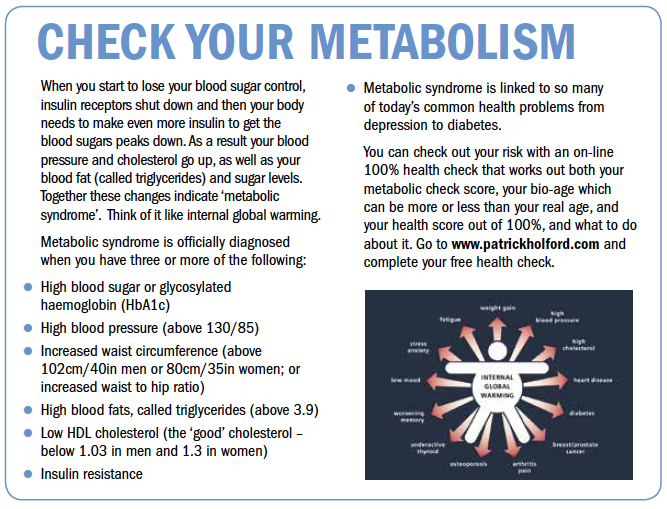
5. CHOOSE RYE, BARLEY AND KAMUT INSTEAD OF WHEAT
Wholegrains have a lower GL than the refined white stuff. Wholegrain rye is best, especially sourdough rye bread and the slow-cooked German-style breads called pumpernickel, sonnenbrot or volkenbrot, all readily available in supermarkets. Whole pearl barley boils like rice and has a very low GL and a delicious nutty taste and chewy texture for soups and ‘risottos’. There is an ancient form of wheat called Kamut® khorosan. In studies it spectacularly improves insulin resistance and lowers blood sugar. It also tastes delicious. Asda has a pre-cooked whole Kamut grain and my favourite is Sgambarro’s Kamut whole wheat pasta. You can also buy kamut flour for baking your own bread.
6. SUPPLEMENT SUPER-FIBRES
Another way to lower the glycemic load of a meal, and thus stabilise blood sugar, is to consume a super-soluble fibre called glucomannan. Having 3-5grams (a teaspoon or three capsules) before a meal helps even out blood sugar response. But you must have it with a large glass of water before a meal because it absorbs the water, thus bulking up what’s in your stomach and making you feel full. Together with a calorieCalories are a measure of the amount of energy in food. Knowing how many calories are in the food we eat allows us to balance… controlled diet supplementing glucomannan fibre helps you lose weight. It is available as PGX and Carboslow online and in health food shops.
7. GO NUTS, SEEDS, BEANS AND LENTILS
Sprinkling chia seeds on your cereal, or eating almonds with an apple all help to lower the GL of a meal or snack. Pulses, the food group that includes beans, lentils and chickpeas, is a staple in countries with low diabetes incidence, but we just don’t eat enough of these highly nutritious foods. Try the seed-like quinoa instead of rice. It was the staple grain of the Incas. It takes 14 minutes to boil, is very high in protein and low GL and absorbs the flavour of sauces.
Pulses are all relatively high in protein, making them lower GL. Including a serving of lentils, or beans, for dinner actually has a knock on effect on breakfast, quite substantially reducing the blood sugar spikes of breakfast the next day.
8. EAT BERRIES, CHERRIES AND PLUMS
Not all fruit is made equal. The principal sugar in most berries, cherries and plums is xylose, making these fruits especially slow-releasing. The bluer the berries the better, so blackcurrants, blackberries, blueberries and cooked black elderberry are all very low GL and very good for you.
In a recent study [2], blueberries were put to the test on a group of overweight, insulin resistant volunteers deemed at high risk of diabetes. They were given a blueberry smoothie every day for six weeks, or an identical-looking and tasting fake smoothie. Those getting the real thing had a 22 per cent increase in their insulin sensitivity. The Montmorency cherry is exceptionally high in antioxidants and Montmorency cherry extract (called Cherry Active), as a cordial, is the only fruit drink I recommend. Since the predominant sugar in cherries is xylose, this drink is relatively low in GL whereas grape juice contains pure glucose. Plums, when in season, are a great fruit snack, together with some protein such as a few almonds or pumpkin seeds.
Prunes are dried plums and three or four on cereal is an alternative fruit, but make sure they haven’t been soaked in sugar. The next best fruits are apples and pears, but the kind of apple or pear you choose makes a difference. The harder and less sweet conference pears, for example, have the lowest GL.
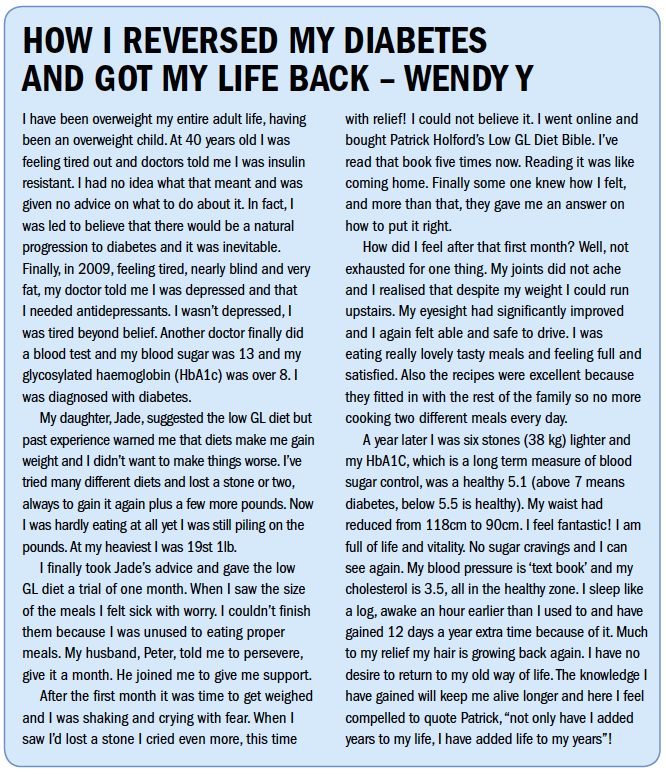
9. SWITCH FROM SUGAR TO XYLITOLXylitol is a completely natural sweetener that looks and tastes like sugar. It is naturally occurring in many fruits and vegetables…. AND INULIN
If you crystalise xylose you get xylitol, a natural white sugar that is great for teeth. Children in Finland are given a xylitol sweet every day because bacteria in the mouth can’t stick to the teeth when they consume xylitol. This sugar alcohol has a GL of 9, which is extremely low. A teaspoon, 5 grams, is only 0.5Gls. My recommended daily allowance for weight loss is 40 GLs. Nine teaspoons of xylitol equals one teaspoon of sugar in terms of GL. Xylitol is great for baking but doesn’t caramelise so it’s no good for crème brulee. It’s no good for dogswho can’t metabolise it. As for prunes (dried plums) lots of xylose or xylitol can promote regularity. Too much can make you too lose.
Chicory root powder is another low GL natural sweetener – a rich source of the resistant starch, inulin. Resistant starches can’t be absorbed, and feed bacteria in the gut which make health promoting fatty acids. They also promote and encourage the growth of healthy bacteria. Inulin has no GL at all, so it’s diabetic heaven. It tastes quite sweet and pleasant.
10. ONE WEEK BLOOD SUGAR FRIENDLY DIET
The secret to losing weight, increasing energy, cutting sugar cravings and preventing diabetes is to eat a low glycaemic load (GL)diet. There are two stages to the low GL diet; weight loss and weight maintenance. On the weight loss diet, which is also appropriate for reversing or controlling diabetes, you should eat no more than 40GLs daily, with an additional 5GLs allowed for a drink or dessert. This is made up of three 10GL main meals and two 5 GL snacks.
Your main meal plate needs to be half vegetables, a quarter protein and a quarter carbohydrateCarbohydrates are the primary source of energy for the body as they can be broken down into glucose (sugar) more readily than either protein or…, so that means less rice, pasta, potatoes than you may be used to.
Here’s three examples of each meal or snack. Pick one of these every day for a week and be amazed at how you feel and how easy it is to lose weight and control blood sugar levels.
BREAKFAST (choose one to make up 10GLs)
- Scrambled or boiled egg with one slice of rye toast or 2 rough oatcakes
- Get Up and Go shake made with skimmed or soya milk and a handful of berries
- Fruit topped with yoghurt and seed.S
MID MORNING SNACK (choose to make up 5GLs)
- A small apple, pear or peach, plus 5 almonds or a tablespoon of pumpkin seeds
- One thin slice of rye bread thinly spread with sugar-free peanut butter
- Smoked salmon, lean meat or hummus with one or two rough oatcakes
LUNCH (choose one to make up 10GLs)
- Roasted chickpea or quinoa Tabouleh
- Apple and tuna salad with oriental green beans and coleslaw
- Spicy lentil and watercress soup
AFTERNOON SNACK (choose one to make up 5GLs)
- Spiced chickpeas
- A small natural bio yoghurt with a handful of berries
- Crudités (carrot, pepper, cucumber or celery) with ¼ of a small tub of hummus
DINNER (choose one make up 10GLs)
- Pasta with borlotti bolognese (see below)
- Steamed or pesto crusted salmon served with cooked greens and brown rice, pearl barley or quinoa (see below)
- Quinoa pilaf with chickpeas and dried cherries
DRINK OR DESSERT(choose one to make up 5GLs)
- A shot of CherryActive concentrate diluted with water.
- A small glass of red or white wine
- Individual berry cheesecake
RECIPES
GET UP AND GO SMOOTHIE WITH BERRIES AND CHIA
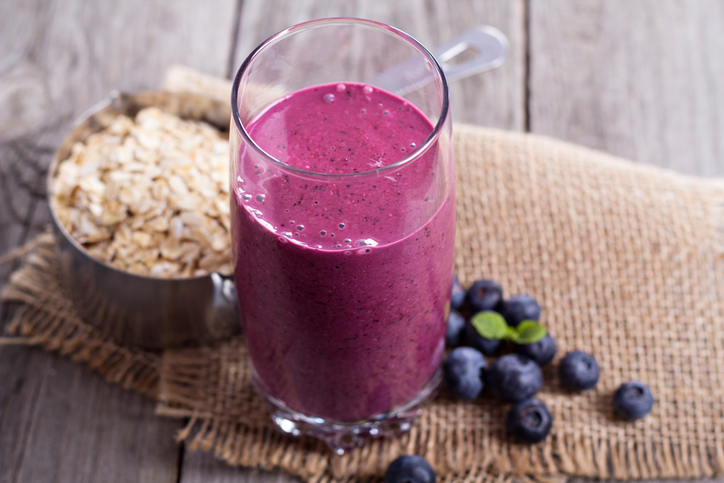
Get Up & Go is a powdered breakfast drink, which is blended with skimmed milk or soya milk and berries. Nutritionally speaking, it is the ultimate breakfast: each serving gives you more fibre than a bowl of porridge, more protein than an egg, more ironWhat it does: As a component of red blood cells, iron transports oxygen and carbon dioxide to and from cells. Also vital for energy production…. than a cooked breakfast and more vitamins and minerals than a whole packet of cornflakes. In fact, every serving of Get Up & Go gives you at least 100 per cent of every vitamin and mineral and a lot more of some key nutrients. For example, you get 1,000mg of vitamin CWhat it does: Strengthens immune system – fights infections. Makes collagen, keeping bones, skin and joints firm and strong. Antioxidant, detoxifying pollutants and protecting against… – the equivalent of more than 20 oranges.
Get Up & Go contains no sucroseSucrose is commonly known as table sugar…., no additives, no animal products, no yeast, wheat or milk, and it tastes delicious. Each serving, with 300ml (10fl oz/1⁄2 pint) skimmed milk or soya milk and some fruit, provides 3GL and fewer than 300 calories and, when mixed up, only 8GL, making it ideal as part of your Anti-diabetes Diet. If you use oat milk, a serving equals 10GL. It is nutritionally superior to any other breakfast choice and is totally suitable for adults and children alike. It is fine to have this for breakfast every day, if you choose. Make it up with berries such as strawberries, raspberries or blueberries, or a soft pear. If you use banana use no more than a third of a decent-sized banana. Get Up & Go is widely available in health-food stores or online at www.holfordirect.com.
PESTO CRUSTED SALMON
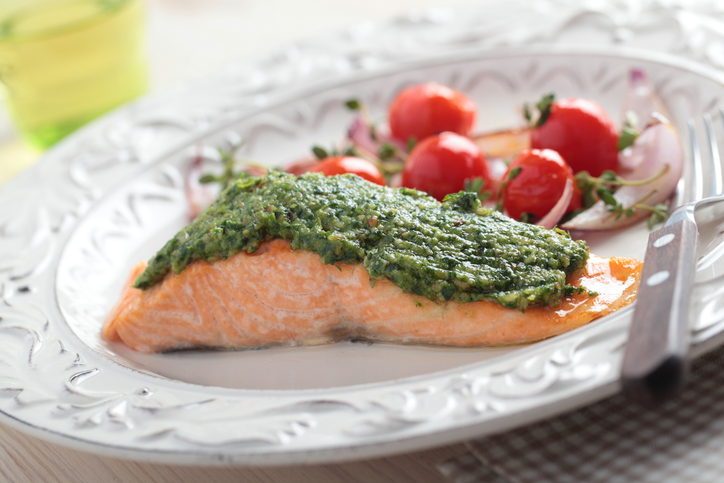
The strong flavours of the pesto work well with salmon, which is high in omega-3. This is a very quick supper that is perfect if you are having friends round and you don’t want the cooking to interrupt the conversation.
SERVES: 2 * GL per serving: 2
2 salmon fillets
2 portions of pesto
Method
* Preheat the oven to 180C/ 350F/Gas 4 and grease a baking tray.
* Put the salmon on the baking tray and spread the pesto on top.
* Bake for 18 minutes or until the flesh flakes easily when pressed.
BORLOTTI BOLOGNESE
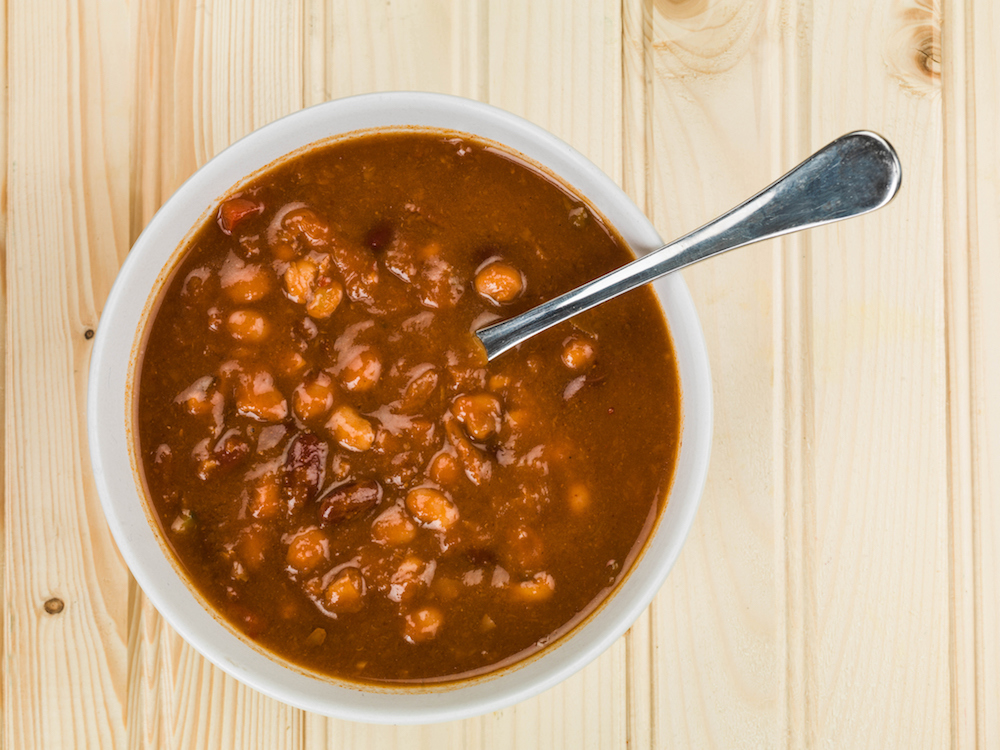
This, a mouth-watering vegetarian alternative to the classic Spag Bol, is packed with fibre. It can be prepared in batches and frozen for convenience. Serves: 2 * GL per serving: 7
INGREDIENTS
2 tsp coconut oil or olive oil
2 garlic cloves crushed
1 onion chopped
115g (4oz) button mushrooms, sliced
1½ tsp Marigold reduced-salt vegetable bouillon powder 1 tsp herbs de Provence 1½ tbsp tomato puree 200g (7oz) canned tomatoes 400g (14oz) can of borlotti beans, drained and rinsed Solo or sea salt ground black pepper
METHOD
* Heat the coconut or olive oil and cook the garlic and onion gently for 2 minutes then add the mushrooms and cook until fairly soft (about 5 minutes).
* Add the vegetable bouillon powder, dried herbs, tomato puree, canned tomatoes and beans, season and simmer for about 10 minutes to allow the vegetables to soften and the sauce to thicken.
SERVING SUGGESTION: Serve with steamed tender stem or broccoli and wholemeal Kamut pasta.
VARIATIONS: Replace the borlotti beens kidney beans or pinto beans
These recipes and many more are taken from the Low-GL Diet Cookbook and my book Say No to Diabetes gives a precise programme to follow to prevent and reverse diabetes.
REFERENCES
- E Balk et al, Diabetes Care, 2007
- AJ Stull et al, J Nutri, 2017

Comments
Join the Conversation on our Facebook Page